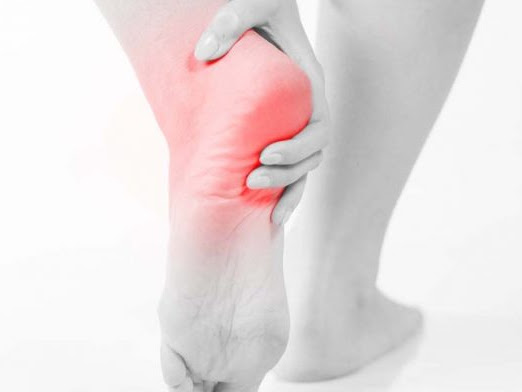Is that first step too painful in the morning??…You may have Plantar Fasciitis. Continue reading to learn more about your Heel Pain.
Is that first step in the morning too painful for you? Does your heel feel sore and achy every time you step on it? Do you have any burning or stabbing pain in your feet? You may have a condition called Plantar Fasciitis.
With summer almost upon us, we all want to get out of the house for our regular exercise. This is the season for walking, running, hiking. However, if you are wrestling with heel pain like this, it can put a damper in the sunshine. It can definitely be debilitating to live with this pain – whether it is excruciating enough to stop your daily activity or just a mild pain. But you are not alone and this is a very common condition which can be effectively managed.
What is Plantar Fasciitis?
Plantar Fascia is the band that covers the sole of your feet – from your heel to your toe. A local inflammation of this fascia, most often due to overuse, is called Plantar Fasciitis.
The most common characteristics of Plantar Fasciitis are
- Heel Pain, which is often the first symptom you may notice. Heel pain can start with just that first step in the morning and decreases with activity. Later it can progress on to a constant pain while weight-bearing on the foot.
- Your heel may be extremely tender or painful to touch and pressure.
- There may even be some swelling over the heel at the site of most pain in severe cases.
What are the causes?
You are probably wondering why you got this condition in the first place. Some of the most common causes and risk factors to develop Plantar Fasciitis are
-
Increased Weight Bearing activities
An increased time on feet is one of the common factors to develop Plantar Fasciitis. This can include work requiring a lot of standing, walking or recreational activities like running. Even athletes are at a risk of developing this overuse condition.
-
Improper Foot Posture
Any abnormal arches in the foot are a risk factor to develop Plantar Fasciitis. The most common is flat foot (reduced footarch) or overpronation of the feet. But, even an excessively high arch can cause this overuse syndrome. You should get a proper foot examination to understand if you have any of these and the different options available to correct or manage it.
-
Inappropriate Footwear
Proper footwear is very important, not just for your feet but for your entire body mechanics. This is especially true if you spend a lot of your time on your feet for work, sport or any recreational activity. If you recently changed your footwear, that could also be the culprit for your pain.
-
Obesity
Obesity increases the pressure on your feet during regular weight-bearing activities and increase the chances of heel pain.
-
Muscle Imbalance or tight muscle
Plantar Fasciitis has also been associated with tight calf or Hamstring muscle and weakness in the foot intrinsic muscles.
Oftentimes, it is not just one factor but a variety of factors that can play a role in you developing this condition.
What can you do to manage it?
It is important to manage Plantar Fasciitis as soon as possible. A few things that have shown to help with Plantar Fasciitis are
- Avoid activities that aggravate your pain
Take frequent breaks from weight-bearing activities. Avoid running, jogging if they are aggravating your pain. You should also avoid walking barefoot on hard surfaces.
-
Ice Bottle Roller
Cold compression helps to relieve the pain. Also, rolling the bottle helps to gently relax and massage the plantar fascia.

- Self Massage
Gently massage your foot to help relax the fascia. You can even use a tennis ball to roll over the foot if there is not too much pain with it.
-
Stretching
You need to stretch the calf muscles to improve the ankle and foot mobility. The plantar fascia can also be stretched gently to relieve the tightness. Hold each stretch for 20 sec and repeat 3 times each.
Calf Stretch – Use a towel to pull your foot towards yourself as shown in the picture. Remember to keep your knee straight. You should feel a good stretch at your calf.
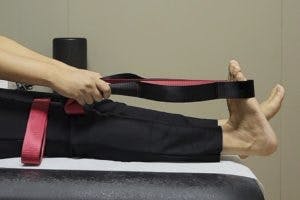
Plantar Fascia Stretch – Gently pull toes up and feel the stretch along the sole of your foot.

-
Ankle Mobility Exercises
These exercises will help to improve your ankle ranges. Move your foot up, down, inwards and outwards to maintain and improve ankle ROM. Perform these exercises 8-10 times.

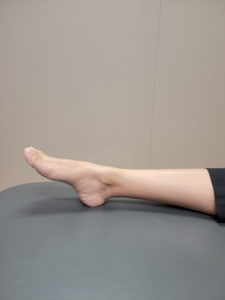
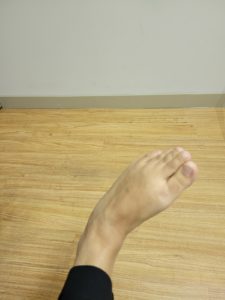
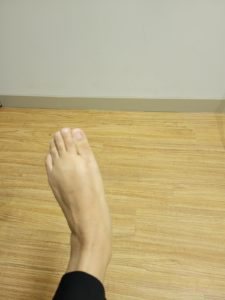
-
Ankle and Foot Strengthening Exercises
Strengthening the muscles of the ankle and foot will help to provide better support to the feet in weight-bearing activities.
-
Footwear and Orthotics
Change your footwear to the ones that provide good support to your arches. Orthotics, are foot inserts that provide support to your foot arches and help maintain a good foot posture. Custom-made orthotics specifically modelled for your feet can relieve the pressure and provide cushion to your heel. A specialist would be able to guide you better about the kind of footwear and orthotics that are good for your feet.
In addition to the above, you would also benefit from getting help from a physiotherapist to address your heel pain. Physiotherapy for Plantar Fasciitis will involve a combination of stretching and strengthening specifically designed for you. A physiotherapist can also use a variety of different treatment modalities and techniques to address your heel pain and help you overcome it. These can involve Shockwave Therapy, Laser Therapy, Taping, various Manual Therapy techniques, etc.
If you want to know more about Physiotherapy for heel pain, you can contact us here at Complete Care Physiotherapy Center. We can help you to recover from your heel pain and get you back to your favourite activities as soon as possible.




